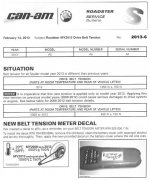finless
New member
I just spotted this on Youtube. Sorry if it has been posted already.
I know that this is not the "approved" BRP way but he explains it pretty well.
Only thing I would add is the 3 reading in different places on the belt and average them.
One thing I find interesting is that many state to get the belt adjusted at the dealer then use the krikit and take a reading. But I have to ask why? Should they all read the same with the krikit?
Bob
I know that this is not the "approved" BRP way but he explains it pretty well.
Only thing I would add is the 3 reading in different places on the belt and average them.
One thing I find interesting is that many state to get the belt adjusted at the dealer then use the krikit and take a reading. But I have to ask why? Should they all read the same with the krikit?
Bob

